Plant Care
Share

Complete Plant Care Guide: Your Green Thumb Success Manual
Your go-to resource for keeping houseplants and garden favorites thriving year-round
Been there, done that with plants that looked gorgeous at the nursery but somehow turned into expensive compost? You're not alone. This straightforward guide cuts through the confusion with real-world advice that works in your actual home.
New to Plant Care? Start Here!
Get everything you need to succeed with our Plant Care Kit - includes our organic Plant Juice, Bloom Juice, and Plant Perfection for comprehensive plant care.
Understanding Your Plant's Basic Needs
Before we dive into specific plants, every plant needs these four things in different amounts:
- Water - More plants die from too much love (overwatering) than neglect
- Light - "Bright indirect" means near a window, not in direct sun
- Soil - Good drainage beats expensive potting mix every time
- Temperature - Most houseplants are happy where you're comfortable
Boost Your Plant Care Success
For the best results, we recommend using Plant Juice - our organic liquid fertilizer that provides over 250 species of beneficial bacteria and fungi to help your plants thrive. Learn more about our feeding schedule for optimal results.
A Plants

Air Plant
The plants that live on air... almost
These little guys are perfect if you've got a track record of loving plants to death.
Care Basics:
- Watering: Water about once a month, water through completely until water drains out the bottom. Water when moisture meter reads 1 or less.
- Soil: Very well-draining soil.
- Sunlight: Bright indirect. Direct sun will burn or kill the plants. Best near a south or west facing window.
- Temperature: 55-90 degrees
Elm Dirt Recommendation for Air Plants:
Use Plant Juice diluted to quarter strength monthly. Mix 1 tsp per gallon for air plants to provide gentle, organic nutrition without overwhelming these sensitive plants.

Anthurium
The tropical beauty that actually blooms indoors
Care Basics:
- Watering: Let 1 inch of soil dry before watering or water when moisture meter reads 7 or less. Does not like to dry out completely.
- Soil: Standard potting mix with extra moss or coir since they do like to stay moist.
- Sunlight: Medium-bright indirect sunlight. Direct sun will burn the leaves.
- Temperature: 65-80 degrees
Elm Dirt Recommendation for Anthuriums:
Feed with Plant Juice every 2 weeks during growing season, then switch to Bloom Juice every 6 weeks to encourage those spectacular flowers. Add Worm Castings to potting mix for optimal drainage and nutrition.

Aloe Vera/Agave
Your first-aid kit that happens to be gorgeous
Care Basics:
- Watering: Water about once a month, water through completely until water drains out the bottom. Water when moisture meter reads 1 or less.
- Soil: Very well-draining soil.
- Sunlight: Bright indirect. Direct sun will burn or kill the plants. Best near a south or west facing window.
- Temperature: 55-90 degrees
Elm Dirt Recommendation for Aloe/Agave:
Use Plant Juice at half strength once monthly during growing season. These drought-adapted plants prefer less frequent feeding. Consider our Ancient Soil for repotting - its excellent drainage is perfect for succulents.

African Violet
The cottage garden classic that loves consistency
Care Basics:
- Watering: Enjoy bottom watering, allow plant to sit for no more than 30 min to absorb its water needs. Water when moisture meter reads 3 or less. Distilled or dechlorinated water is preferred.
- Soil: Well-draining, airy, slightly acidic soil.
- Sunlight: At least 12 hours of medium-bright indirect sunlight. South or east facing window is ideal.
- Temperature: 65-80 degrees. 70 degrees is ideal.
Elm Dirt Recommendation for African Violets:
African violets are sensitive to water quality, so use Plant Juice with distilled water. Feed every 2 weeks with Plant Juice, then switch to Bloom Juice every 6 weeks for continuous flowering. Check out our detailed African Violet care guide.

Alocasia
Care Basics:
- Watering: Water when the top 2 inches of soil has dried out or moisture meter reads 6 or less. Keep the soil moist but never soggy allowing the plant to dry out a bit in between watering.
- Soil: Well-draining, loose and nutrient rich potting mix.
- Sunlight: Medium-bright indirect sunlight. Near a south or east facing window is ideal. Direct sun will burn the foliage.
- Temperature: 65-80 degrees
Elm Dirt Recommendation for Alocasia:
These tropical beauties love consistent nutrition. Use Plant Juice every 2 weeks during growing season. Add Worm Castings to your potting mix for the loose, nutrient-rich soil these plants crave.
B Plants
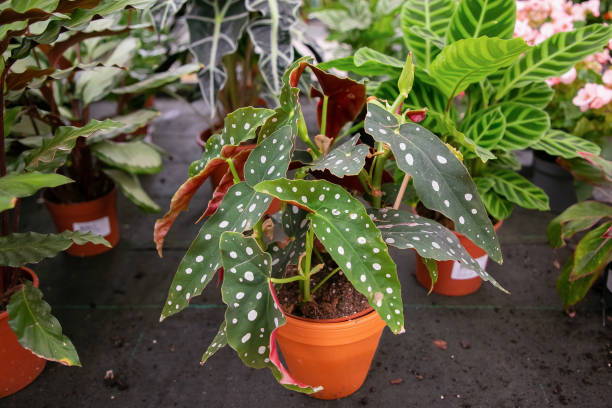
Begonias
Colorful, easy-going, and surprisingly tough
Care Basics:
- Watering: Soil likes to be consistently moist, water when top inch of soil is dry. Water when moisture meter reads 6 or less.
- Soil: Well-draining potting mix.
- Sunlight: Bright indirect light. Morning sun when placed outdoors.
- Temperature: 65-75 degrees
Elm Dirt Recommendation for Begonias:
Feed with Plant Juice every 2 weeks, then switch to Bloom Juice every 6 weeks for spectacular flowers. These flowering plants especially benefit from our targeted bloom nutrition.
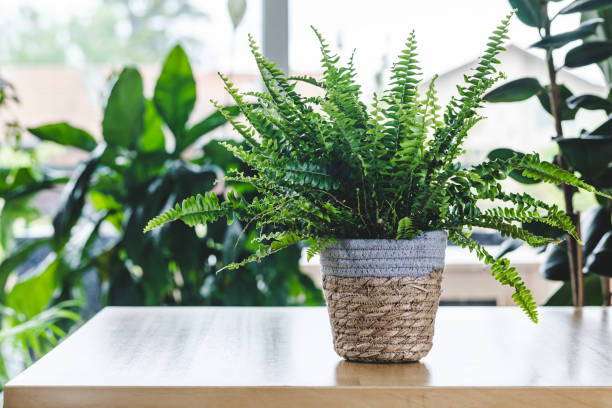
Boston Ferns
The hanging basket stars that purify your air
Care Basics:
- Watering: Ferns need to have consistently moist soil. Water when soil is at all dry to touch. Water when moisture meter reads 7 or less.
- Soil: Moisture retaining potting mix with good drainage.
- Sunlight: Medium-bright indirect light. Keep in the shade if placing outdoors.
- Temperature: 65-75 degrees
Elm Dirt Recommendation for Boston Ferns:
Ferns love consistent moisture and nutrition. Use Plant Juice every 2 weeks during growing season. Mix Worm Castings into your potting mix for moisture retention and gentle, steady nutrition.
C Plants

Cacti
Care Basics:
- Watering: Allow soil to dry out completely between watering. Check every 2 weeks, water less frequently in the winter. Water when moisture meter reads 1 or less.
- Soil: Very fast well-draining soil. Any cacti/succulent mix will work.
- Sunlight: Very bright indirect. South facing window is ideal. If cacti are turning yellow or brown it needs less direct sunlight.
- Temperature: 75-95 degrees
Elm Dirt Recommendation for Cacti:
Use Plant Juice at quarter strength once monthly during growing season only. Cacti prefer minimal feeding. Our Ancient Soil provides excellent drainage perfect for cacti and succulents.
D Plants
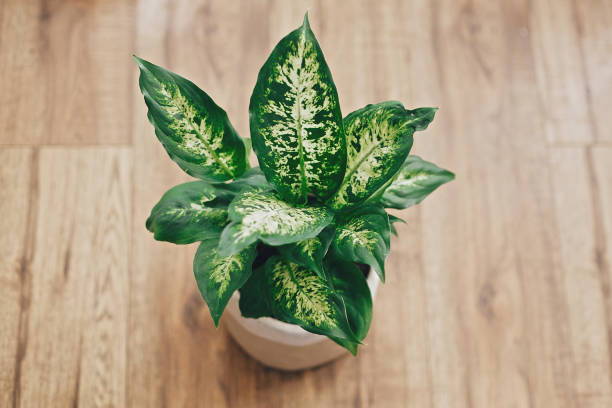
Dieffenbachia/Dumb Cane
Care Basics:
- Watering: Water when the top 2 inches of soil are dry. If leaves are droopy it is time to water. Water when moisture meter reads 3 or less.
- Soil: Rich well-draining soil. A mix higher in peat moss is ideal.
- Sunlight: Medium indirect light.
- Temperature: 50-90 degrees
Elm Dirt Recommendation for Dieffenbachia:
These foliage plants thrive with Plant Juice every 2 weeks during growing season. The rich nutrition helps maintain those beautiful variegated leaves. Mix Worm Castings into potting mix for the rich, well-draining soil they prefer.

Dracaena
Care Basics:
- Watering: Allow the top 1 inch of water to dry out before watering. Water plant all the way through till water drains out of the bottom. Keep soil slightly moist never soggy. Water when moisture meter reads 7 or less.
- Soil: Standard potting mix with good drainage and moisture retention.
- Sunlight: Medium-bright indirect sunlight. Direct sun will burn the leaves.
- Temperature: 65-78 degrees
Elm Dirt Recommendation for Dracaena:
Dracaenas are excellent beginner plants that respond well to Plant Juice every 2 weeks. Their slow growth means they don't need heavy feeding, making our gentle organic nutrition perfect for them.
E Plants
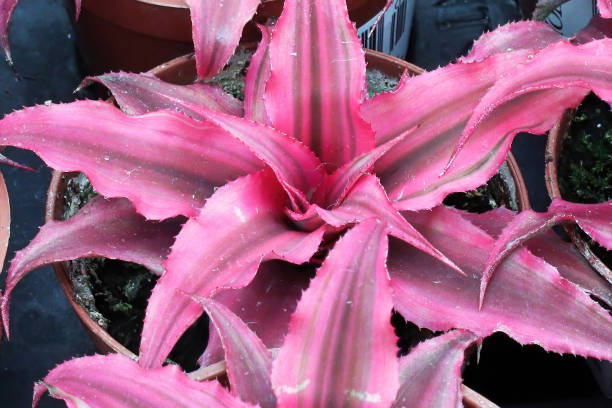
Earth Star
Care Basics:
- Watering: Do not water this plant in the center rosette, it can rot the plant. Allow the top 2 inches of soil to dry before watering. The soil should stay lightly moist but never soggy.
- Soil: Porous moist soil. Peat moss and sand are good additives to achieve moist good draining soil.
- Sunlight: Medium bright indirect light, direct will burn the leaves.
- Temperature: 50-90 degrees
Elm Dirt Recommendation for Earth Star:
These delicate bromeliads prefer gentle nutrition. Use Plant Juice at half strength monthly. Add Worm Castings to create the porous, moist soil they need.
F Plants

Fiddle Leaf Fig
Care Basics:
- Watering: Check every 1-2 weeks, wait until top 2 inches of soil has dried out. These plants enjoy a thorough watering with dry spells in between like they receive in their natural environment. Water when moisture meter reads 4 or less.
- Soil: Well-draining soil high in organic matter. Peat based soil with perlite works great.
- Sunlight: Bright indirect sunlight. It does great near a south facing window or in an east facing window.
- Temperature: 60-80 degrees
Elm Dirt Recommendation for Fiddle Leaf Fig:
FLF's thrive with consistent nutrition. Use Plant Juice every 2 weeks during growing season. Our Ancient Soil provides the perfect well-draining, organic-rich base. Read our complete Fiddle Leaf Fig care guide.
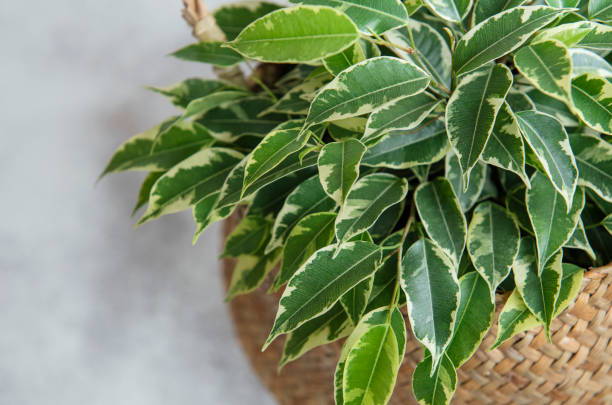
Ficus
Care Basics:
- Watering: These plants need consistency to thrive. Water when top 2 inches of soil dries out or when moisture meter reads 4 or less.
- Soil: Use well-draining fertile soil to prevent root rot and allow the soil to drain properly.
- Sunlight: Bright indirect light.
- Temperature: 65-85 degrees
Elm Dirt Recommendation for Ficus:
Ficus plants respond well to consistent nutrition. Use Plant Juice every 2 weeks during growing season. Our Ancient Soil provides the well-draining, fertile base these plants need.

Florida Green Philodendron
Care Basics:
- Watering: Water thoroughly when top 2 inches of soil is dry or when moisture meter reads 4 or less. Do not over water this will cause root rot.
- Soil: Well-draining soil rich in organic matter.
- Sunlight: Bright indirect light, direct sunlight will turn the foliage yellow.
- Temperature: 75-80 degrees
Elm Dirt Recommendation for Florida Green Philodendron:
These tropical climbers thrive with Plant Juice every 2 weeks. Mix Worm Castings into your potting mix for the rich organic matter they love.

Fruit Tree (Potted)
Care Basics:
- Watering: Water when top 2 inches of soil is dry.
- Soil: Standard potting mix should work; it should have drainage while also staying moist but not soggy.
- Sunlight: They need 6-8 hours of sunlight every day during the growing season. South window or south side of the house is ideal.
- Temperature: 55-90 degrees
Elm Dirt Recommendation for Fruit Trees:
Fruit trees need consistent nutrition for good yields. Use Plant Juice every 2 weeks during growing season, then Bloom Juice every 6 weeks when flowering/fruiting. Our Ancient Soil provides excellent drainage with moisture retention.
G Plants

Gardenia
Care Basics:
- Watering: Keep soil consistently moist. Do not let the soil dry out or become soggy. Water when top 1 inch of soil has dried out or when moisture meter reads 6 or less.
- Soil: Acidic soil, well-draining and rich in nutrients.
- Sunlight: Can tolerate full sun to light shade.
- Temperature: 55-90 degrees
Elm Dirt Recommendation for Gardenia:
Gardenias love acidic conditions and rich nutrition. Use Plant Juice every 2 weeks, then Bloom Juice every 6 weeks for those fragrant blooms. Add Worm Castings for the acidic, nutrient-rich soil they prefer.
H Plants

Hoya
Care Basics:
- Watering: Water when the top 2 inches of soil dries out or when moisture meter reads 3 or less. Water thoroughly until water drains out the drainage hole. Never make the soil soggy.
- Soil: Standard well-draining potting mix that can still retain enough moisture for the plant.
- Sunlight: Bright indirect light. Near a south or east facing window is ideal. Direct sun will burn the foliage.
- Temperature: 60-85 degrees
Elm Dirt Recommendation for Hoya:
Hoyas prefer less frequent but consistent nutrition. Use Plant Juice every 3 weeks during growing season, then Bloom Juice every 6 weeks for those spectacular waxy flowers.

Herbs
Care Basics:
- Watering: Water thoroughly allowing soil to dry out in between watering.
- Soil: Standard gardening soil or organic potting mix work great.
- Sunlight: Bright light, herbs need 6 hours of sunlight outdoors. Herbs require 12-16 hours of light with grow lights or in a south facing window if indoors.
- Temperature: 55-70 degrees
Elm Dirt Recommendation for Herbs:
Herbs benefit from organic nutrition for the best flavor. Use Plant Juice every 2 weeks during growing season. Our organic approach enhances natural flavors without chemical residues. Check our growing herbs indoors guide.
I Plants
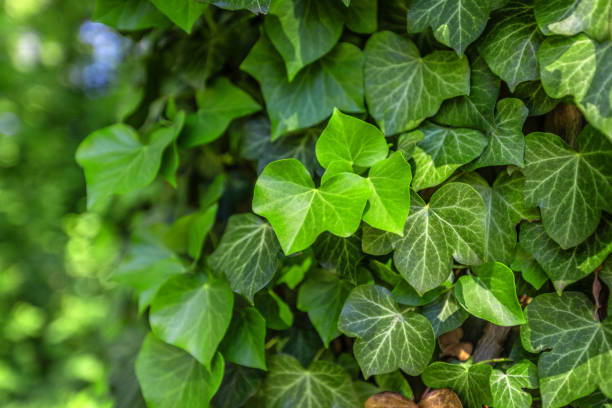
Ivy (General)
Care Basics:
- Watering: Water when top 2 inches of soil dry out. Most ivy varieties prefer to dry out slightly between waterings. Water when moisture meter reads 4 or less.
- Soil: Well-draining potting mix with good aeration.
- Sunlight: Bright indirect light to partial shade. Can tolerate lower light conditions.
- Temperature: 60-75 degrees
Elm Dirt Recommendation for Ivy:
Fast-growing ivy responds well to regular feeding. Use Plant Juice every 2 weeks during growing season for lush, vigorous growth.

Impatiens
Care Basics:
- Watering: Keep soil consistently moist but not waterlogged. Water when top inch of soil feels dry. Water when moisture meter reads 6 or less.
- Soil: Rich, well-draining potting mix that retains some moisture.
- Sunlight: Partial shade to bright indirect light. Direct sun can scorch the delicate leaves.
- Temperature: 65-75 degrees
Elm Dirt Recommendation for Impatiens:
These continuous bloomers need steady nutrition. Use Plant Juice every 2 weeks, then Bloom Juice every 6 weeks for non-stop flowering all season.
J Plants

Jade
Care Basics:
- Watering: Water when soil has dried out a bit or when moisture meter reads 3 or less.
- Soil: Well-draining potting mix.
- Sunlight: Medium-bright indirect light.
- Temperature: 65-75 degrees
Elm Dirt Recommendation for Jade:
Jade plants prefer minimal feeding. Use Plant Juice at half strength once monthly during growing season. Our Ancient Soil provides the excellent drainage these succulents need.
K Plants
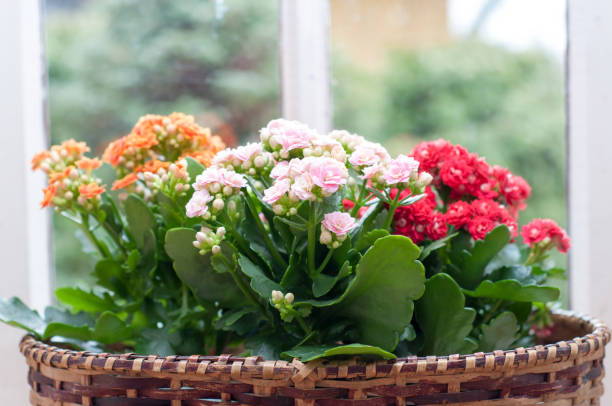
Kalanchoe
Care Basics:
- Watering: Let the top 2 inches of soil dry out before watering. These plants like to dry out in between watering. Water when moisture meter reads 1 or less.
- Soil: Well-draining cactus/succulent mix.
- Sunlight: Bright indirect light.
- Temperature: 60-85 degrees
Elm Dirt Recommendation for Kalanchoe:
These flowering succulents benefit from gentle nutrition. Use Plant Juice at quarter strength monthly, then Bloom Juice at quarter strength during blooming season.
L Plants

Lady Palm
Care Basics:
- Watering: Keep soil consistently moist throughout. Allow soil to dry out in between watering. Water when moisture meter reads 4 or 5.
- Soil: Slightly acidic soil, sandy soil rich in organic matter with good drainage.
- Sunlight: Medium-bright indirect light.
- Temperature: 60-80 degrees
Elm Dirt Recommendation for Lady Palm:
These slow-growing palms prefer gentle, consistent nutrition. Use Plant Juice every 3 weeks during growing season. Add Worm Castings for the organic-rich, slightly acidic soil they prefer.

Lavender
Care Basics:
- Watering: Water deeply once soil has dried out completely.
- Soil: Well-draining soil.
- Sunlight: Full sun outdoors, in a south facing window inside.
- Temperature: 68-86 degrees
Elm Dirt Recommendation for Lavender:
Lavender prefers minimal feeding to maintain its essential oils. Use Plant Juice at quarter strength once monthly during growing season only. Our Ancient Soil provides the excellent drainage lavender requires.
M Plants

Maranta
Care Basics:
- Watering: Water when topsoil dries out half way down or when moisture meter reads 6 or less.
- Soil: Standard well-draining potting mix.
- Sunlight: Medium-bright indirect sunlight. Direct sun will burn the leaves.
- Temperature: 65-85 degrees
Elm Dirt Recommendation for Maranta:
These prayer plants are sensitive to water quality. Use Plant Juice with distilled water every 2 weeks during growing season for best results with these finicky but beautiful plants.

Monstera
The Instagram star that's surprisingly easy
Care Basics:
- Watering: Water when top 2 inches of soil dries out or when moisture meter reads 4 or less.
- Soil: Standard well-draining potting mix.
- Sunlight: 5-8 hours of medium-bright indirect sunlight. Direct sun will burn the leaves.
- Temperature: 65-85 degrees
Elm Dirt Recommendation for Monstera:
These fast-growing beauties love consistent nutrition. Use Plant Juice every 2 weeks during growing season. Add Worm Castings to your potting mix for the rich soil these tropical plants crave.
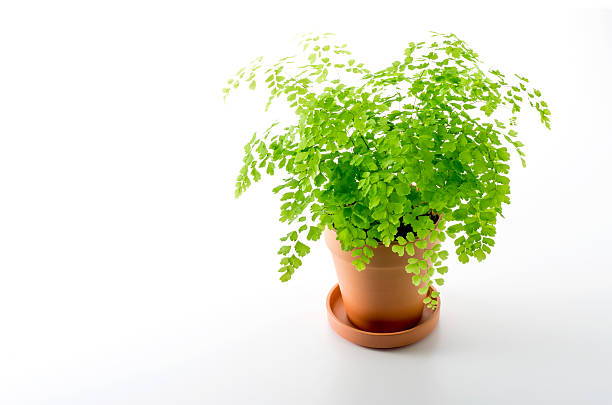
Maidenhair Fern
Care Basics:
- Watering: Water every other day or every few days. Moisture meter will read 7 or less when it is time to water. These plants need consistent moisture.
- Soil: Standard well-draining potting mix. Make sure the soil can retain moisture while allowing air flow and drainage.
- Sunlight: Low-medium indirect sunlight. Direct rays will kill this plant, but too little rays can cause problems as well.
- Temperature: 60-80 degrees
Elm Dirt Recommendation for Maidenhair Fern:
These delicate ferns need gentle, consistent nutrition. Use Plant Juice at half strength every 2 weeks. Mix Worm Castings into potting mix for moisture retention and gentle nutrition.
N Plants

Nerve Plant
Care Basics:
- Watering: Water when soil is dry to touch, every 4-7 days and less in winter. Water when moisture meter reads 5 or less.
- Soil: Potting mix with drainage and moisture retention. A high peat based mix is ideal.
- Sunlight: Low-medium filtered light (near a window with a sheer curtain would be considered filtered light).
- Temperature: 60-80 degrees
Elm Dirt Recommendation for Nerve Plant:
These colorful beauties respond well to gentle nutrition. Use Plant Juice at half strength every 2 weeks. Add Worm Castings to create the peat-rich mix they prefer.

Norfolk Island Pine
Care Basics:
- Watering: Water when top 2 inches of soil dries out or moisture meter reads 4 or less.
- Soil: Standard potting mix with good drainage.
- Sunlight: Bright indirect light, near a south facing window is ideal.
- Temperature: 65-75 degrees
Elm Dirt Recommendation for Norfolk Island Pine:
These slow-growing conifers prefer gentle feeding. Use Plant Juice every 3 weeks during growing season. They appreciate the organic nutrition without over-stimulation.
O Plants
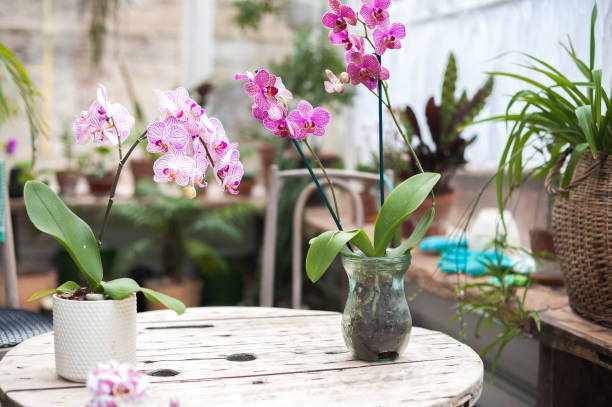
Orchid
The diva that's worth the drama
Care Basics:
- Watering: Water once every 1-2 weeks. Let the bark or moss dry out completely before watering. Overwatering will kill orchids fast. Water when moisture meter reads 1 or less.
- Soil: No soil, you will want to use orchid bark or moss for these plants. They need extremely well drainage and air flow. These plants grow on trees in nature and do not have anything covering the roots.
- Sunlight: Bright indirect light. Near a east or south facing window is ideal.
- Temperature: 55-85 degrees
Elm Dirt Recommendation for Orchids:
Orchids need specialized care and feeding. Use Plant Juice at quarter strength monthly during growing season, and Bloom Juice at quarter strength during blooming. Use our Orchid Bark for proper drainage and air circulation. Read our orchid care guide for detailed instructions.
P Plants

Peperomia
Care Basics:
- Watering: Water when soil has dried out almost completely or when moisture meter reads 3 or less.
- Soil: Very well-draining mix. A cactus/succulent mix with additional peat moss added is ideal.
- Sunlight: Bright indirect light.
- Temperature: 60-80 degrees
Elm Dirt Recommendation for Peperomia:
These compact beauties prefer less frequent feeding. Use Plant Juice at half strength every 3 weeks during growing season. Mix Worm Castings with cactus mix for ideal drainage.

Philodendron
Care Basics:
- Watering: Water when top 2 inches of soil dries out or when moisture meter reads 4 or less.
- Soil: Standard potting mix with good drainage and water retention.
- Sunlight: Medium-bright indirect light.
- Temperature: 65-85 degrees
Elm Dirt Recommendation for Philodendron:
These versatile climbing plants love consistent nutrition. Use Plant Juice every 2 weeks during growing season. Add Worm Castings to your potting mix for the rich, well-draining soil they prefer.

Pilea
Care Basics:
- Watering: Water when top 1 inch of soil has dried out or when moisture meter reads 7 or less.
- Soil: Standard potting mix with good drainage.
- Sunlight: Bright indirect sunlight, direct sun will burn the leaves.
- Temperature: 55-85 degrees
Elm Dirt Recommendation for Pilea:
These "friendship plants" propagate easily and respond well to regular feeding. Use Plant Juice every 2 weeks during growing season for vigorous growth and plenty of baby plants to share.

Palms
Care Basics:
- Watering: Let palms dry out in between watering, avoid over watering as this is the number one killer of palms. Water palms when soil is dry halfway down or when moisture meter reads 1 or less.
- Soil: Standard potting mix with good drainage.
- Sunlight: Low-bright indirect light. These plants cannot tolerate any direct sunlight.
- Temperature: 60-80 degrees
Elm Dirt Recommendation for Palms:
Palms prefer gentle, infrequent feeding. Use Plant Juice every 3-4 weeks during growing season. Over-feeding can damage their sensitive root systems.

Pothos
The plant that forgives everything
If you can only keep one plant alive, make it a pothos.
Care Basics:
- Watering: Let the soil dry out a bit in between watering. Water when top 2 inches of soil dries out or when moisture meter reads 4 or less.
- Soil: Standard, well-draining potting mix.
- Sunlight: Medium-bright indirect light. Direct sun will burn the leaves.
- Temperature: 60-70 degrees
Elm Dirt Recommendation for Pothos:
These forgiving favorites thrive with Plant Juice every 2 weeks during growing season. They're perfect for beginners and respond beautifully to organic nutrition, producing lush, trailing vines.

Peace Lily
The plant that tells you when it's thirsty
These dramatic beauties literally droop when they need water.
Care Basics:
- Watering: Keep the soil consistently moist but not soggy, the soil should not dry out. Water when top 1 inch of soil is dry or when moisture meter reads 7 or less.
- Soil: Standard potting mix with moisture retention and good drainage.
- Sunlight: Medium-bright indirect light. If the peace lily is not blooming, it probably needs brighter indirect light.
- Temperature: 60-80 degrees
Elm Dirt Recommendation for Peace Lily:
Peace lilies are excellent bloomers with proper nutrition. Use Plant Juice every 2 weeks, then Bloom Juice every 6 weeks for those elegant white flowers. They respond beautifully to organic feeding.

Pony Tail Palm
Care Basics:
- Watering: Let soil dry out in between watering. Water when soil is dry halfway down or when moisture meter reads 1 or less.
- Soil: Very well-draining soil. Cactus/succulent soil would work well.
- Sunlight: Bright indirect light, near a south facing window is ideal.
- Temperature: 60-85 degrees
Elm Dirt Recommendation for Pony Tail Palm:
These drought-tolerant beauties prefer minimal feeding. Use Plant Juice at quarter strength once monthly during growing season. Our Ancient Soil provides the excellent drainage they need.
Q Plants

Queen of the Night
Care Basics:
- Watering: Let dry out completely between watering. Water when moisture meter reads 1 or less.
- Soil: Well-draining potting mix. Cactus/succulent or orchid mix would work great.
- Sunlight: Bright indirect light.
- Temperature: 50-90 degrees
Elm Dirt Recommendation for Queen of the Night:
This rare night-blooming cactus needs minimal feeding. Use Plant Juice at quarter strength monthly during growing season, and Bloom Juice at quarter strength when buds appear.
R Plants

Rhaphidophora Hayi (Shingle Plant)
Care Basics:
- Watering: Water when top 2 inches of soil has dried out a bit or when moisture meter reads 4 or less.
- Soil: Standard potting mix with moisture retention and good drainage.
- Sunlight: Bright indirect light, direct sun will make the leaves brown and crispy.
- Temperature: 60-78 degrees
Elm Dirt Recommendation for Rhaphidophora Hayi:
This rare climbing beauty loves consistent nutrition. Use Plant Juice every 2 weeks during growing season. Consider our Aroid Mix for the perfect well-draining, moisture-retentive soil these aroids prefer.

Rose
Care Basics:
- Watering: Water at least once a week during growing season. Require at least an inch of water weekly.
- Soil: Standard potting mix that is well-draining and rich in humus.
- Sunlight: 4 hours of direct sun at a minimum. Roses require direct sunlight to thrive.
- Temperature: 60-70 degrees is ideal.
Elm Dirt Recommendation for Roses:
Roses are heavy feeders that love organic nutrition. Use Plant Juice every 2 weeks during growing season, then Bloom Juice every 6 weeks for spectacular blooms. Add Worm Castings as a top dressing monthly. Read our complete rose care guide.

Rubber Plant
Care Basics:
- Watering: Water when top 2 inches of soil dries out or when moisture meter reads 4 or less.
- Soil: Standard potting mix with good drainage.
- Sunlight: Bright indirect light.
- Temperature: 60-80 degrees
Troubleshooting Common Problems
Yellowing Leaves
- Most common cause: Overwatering
- Solution: Check moisture meter, improve drainage, reduce watering frequency
Brown Leaf Tips
- Most common causes: Low humidity, water quality, or fertilizer burn
- Solution: Increase humidity, switch to distilled water, reduce fertilizing
Drooping Plants
- Could be: Underwatering, overwatering, or temperature shock
- Solution: Check soil moisture first, then consider recent changes in location or temperature
📏 Leggy Growth
- Cause: Not enough light
- Solution: Move closer to window or add grow lights
Elm Dirt Problem-Solving Solutions
Many plant problems stem from poor nutrition or stressed roots. Our Plant Juice contains beneficial microbes that help plants resist stress and disease. For comprehensive troubleshooting, check out our plant diagnostics guide and FAQ troubleshooting page.
Seasonal Care Adjustments
Spring & Summer (Growing Season)
- Water more frequently as plants actively grow
- This is the time to fertilize (if you choose to)
- Perfect season for repotting
Fall & Winter (Rest Period)
- Reduce watering frequency
- Stop fertilizing
- Don't expect much new growth - this is normal
Elm Dirt Seasonal Feeding Schedule
Spring/Summer: Use Plant Juice every 2 weeks, Bloom Juice every 6 weeks for flowering plants.
Fall/Winter: Reduce to Plant Juice once monthly or stop feeding completely in colder months. Read our complete seasonal feeding guide and fall preparation tips.
Ready to Start Your Plant Journey?
Plant care doesn't have to be complicated. Start with one or two easy plants, get comfortable with their needs, then expand your collection.
1. Pick 1-2 plants from this guide that match your lifestyle
2. Get a moisture meter (seriously, game-changer)
3. Find a good spot with appropriate light
4. Start simple and build confidence
Remember: Every plant parent has killed plants. It's part of the learning process. The goal isn't perfection - it's enjoying the process and creating a greener, more beautiful space.
Complete Plant Care Solutions from Elm Dirt
For Beginners:
Plant Care Kit Starter KitIndividual Products:
Plant Juice - All-Purpose Bloom Juice - For Flowers Ancient Soil - Premium Mix Worm CastingsSpecialized Care:
Aroid Mix Orchid Bark Seedling MixLearn More:
Check out our comprehensive guides:





